2.12.2021
NASA TV to Air IXPE Prelaunch Activities, Launch
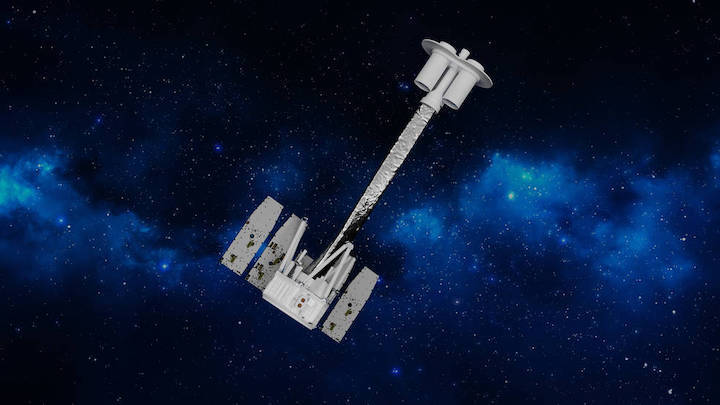
NASA will provide coverage of the upcoming prelaunch and launch activities for the Imaging X-ray Polarimetry Explorer (IXPE) mission, the first satellite dedicated to measuring the polarization of X-rays from a variety of cosmic sources, such as black holes and neutron stars.
IXPE is scheduled to launch no earlier than 1 a.m. EST Thursday, Dec. 9, on a SpaceX Falcon 9 rocket from Launch Complex 39A at NASA’s Kennedy Space Center in Florida.
Live launch coverage will begin at 12:30 a.m. on NASA Television, the NASA app, and the agency’s website. On Tuesday, Dec. 7, NASA will hold a payload briefing at 1 p.m. and a prelaunch news briefing at 5:30 p.m.
The IXPE spacecraft includes three space telescopes with sensitive detectors capable of measuring the polarization of cosmic X-rays, allowing scientists to answer fundamental questions about extremely complex environments in space where gravitational, electric, and magnetic fields are at their limits. The project is a collaboration between NASA and the Italian Space Agency.
All media participation in news conferences will be remote except where noted otherwise. For the protection of employees and journalists in the ongoing COVID-19 pandemic, the Kennedy Press Site facilities will be open to a limited number of journalists on a first-come, first-served basis.
Full mission coverage is as follows (all times Eastern):
Tuesday, Dec. 7
1 p.m. – IXPE Payload Briefing, with the following participants:
- Elisabetta Cavazzuti, ASI IXPE program manager, Italian Space Agency
- Luca Baldini, Italian co-principal investigator, National Institute for Nuclear Physics
- Brian Ramsey, deputy principal investigator, NASA’s Marshall Space Flight Center
- MacKenzie Ferrie, IXPE program manager, Ball Aerospace
For the payload briefing dial-in number and passcode, please contact the Kennedy newsroom at: ksc-newsroom@mail.nasa.gov no later than 4 p.m. Monday, Dec. 6. Members of the public also may ask questions, which may be answered in real-time during the segment, by using #AskNASA on social media. A limited number of seats will be available to media on-site.
5:30 p.m. – IXPE Prelaunch News Conference with the following participants:
- Sandra Connelly, deputy associate administrator for science, NASA Headquarters
- Martin Weisskopf, IXPE principal investigator, Marshall
- Makenzie Lystrup, vice president and general manager, civil space, Ball Aerospace
- Tim Dunn, launch director, NASA’s Launch Services Program
- Julianna Scheiman, director, civil satellite missions, SpaceX
- Mike McAleenan, 45th Weather Squadron, Space Launch Delta 45
For the prelaunch news conference dial-in number and passcode, please contact the Kennedy newsroom at: ksc-newsroom@mail.nasa.gov no later than noon Tuesday, Dec. 7. Members of the public also may ask questions, which may be answered in real-time during the segment, by using #AskNASA on social media. A limited number of seats will be available to media on-site.
Thursday, Dec. 9
12:30 a.m. - NASA TV live launch coverage begins.
Audio only of the news conferences and launch coverage will be carried on the NASA “V” circuits, which may be accessed by dialing 321-867-1220, -1240, -1260 or -7135. On launch day, "mission audio," countdown activities without NASA TV launch commentary, will be carried on 321-867-7135. A “clean feed” of the launch without NASA TV commentary will be carried on the NASA TV media channel.
NASA selected IXPE as a Small Explorer mission in 2017. NASA’s Launch Services Program is managing this launch. NASA’s Marshall Space Flight Center in Huntsville, Alabama, manages the IXPE mission. Ball Aerospace, headquartered in Broomfield, Colorado, manages spacecraft operations with support from the University of Colorado at Boulder. NASA’s Goddard Space Flight Center in Greenbelt, Maryland, manages the Explorers Program for the agency’s Science Mission Directorate in Washington. The U.S. Space Force’s Space Launch Delta 45 provides range support for this launch. SpaceX is providing the launch vehicle for this mission.
Quelle: NASA
+++

IXPE Home: Expanding the X-ray View of the Universe
The Imaging X-ray Polarimetry Explorer (IXPE) exploits the polarization state of light from astrophysical sources to provide insight into our understanding of X-ray production in objects such as neutron stars and pulsar wind nebulae, as well as stellar and supermassive black holes. Launch has been set for December 9, 2021. Technical and science objectives include:
- improving polarization sensitivity by two orders of magnitude over the X-ray polarimeter aboard the Orbiting Solar Observatory OSO-8(scientists see HEASARC: Observatories),
- providing simultaneous spectral, spatial, and temporal measurements,
- determining the geometry and the emission mechanism of Active Galactic Nuclei and microquasars,
- finding the magnetic field configuration in magnetars and determining the magnitude of the field,
- finding the mechanism for X ray production in pulsars (both isolated and accreting) and the geometry,
- determining how particles are accelerated in Pulsar Wind Nebulae.
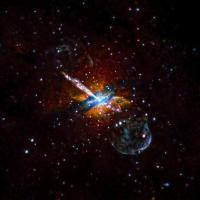 This image from the Chandra X-ray Observatory, shows a jet emanating from the central, supermassive black hole of Centaurus A. The colors in this image represent the energy of the detected X rays, with red for low, green for middle, and blue representing high-energy X rays. Astrophysical objects like this one, are good candidates for observations of polarization that will give us information about the object's magnetic field and its configuration. For more information on this image, you may visit the Chandra X-ray Observatory's website.
This image from the Chandra X-ray Observatory, shows a jet emanating from the central, supermassive black hole of Centaurus A. The colors in this image represent the energy of the detected X rays, with red for low, green for middle, and blue representing high-energy X rays. Astrophysical objects like this one, are good candidates for observations of polarization that will give us information about the object's magnetic field and its configuration. For more information on this image, you may visit the Chandra X-ray Observatory's website.
Quelle: NASA
+++
Meet the IXPE Team: Kelley Jones-McDowall
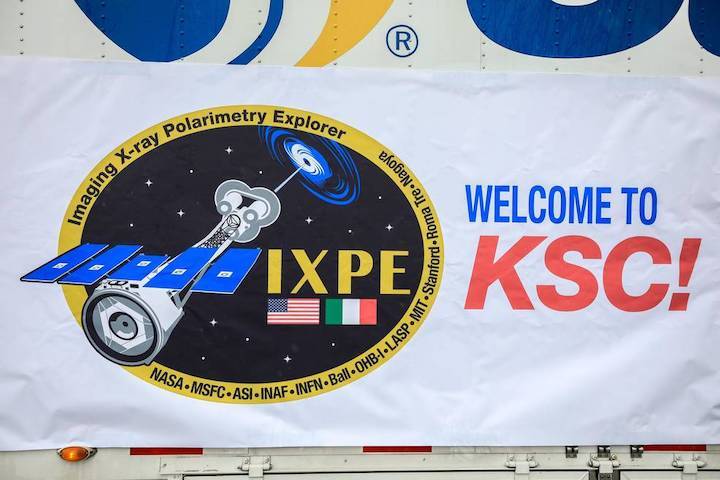
Editor's note: This is the third in a series of five features introducing members of the IXPE team. The features will run weekly through Dec. 8.
By Jim Cawley
NASA’s Kennedy Space Center
The Imaging X-Ray Polarimetry Explorer (IXPE), NASA’s first mission dedicated to measuring X-ray polarization, is targeted for launch on Thursday, Dec. 9, 2021, aboard a SpaceX Falcon 9 rocket from NASA’s Kennedy Space Center’s Launch Complex 39A in Florida. IXPE will study changes in the polarization of X-ray light through some of the universe’s most extreme sources – including black holes, dead stars known as pulsars, and more – to help astronomers better understand these exotic cosmic phenomena.
Meet one of the key members of the launch team:
Name: Kelley Jones-McDowall
Official title: Launch Services Program (LSP) Senior Vehicle Systems Engineer (VSE)
Job responsibilities: I am the lead VSE for the SpaceX fleet. My job as the lead is to make sure we are on top of major changes and issues, and to strategically look ahead and figure out how we can better optimize ourselves as a team. In preparation for NASA’s Double Asteroid Redirection Test (DART) and IXPE missions, I created and managed a system that helps the team keep track of fleet changes, risks, and issues. I also set up the tools and systems for DART and IXPE mission-specific activities. In addition, I work with the technical authorities to prepare the team and program to work with flight-proven boosters.
Time working for NASA: I started in 2008 as a summer intern at Kennedy. I was a co-op (now called a Pathways Intern) in spring 2009 and then began full-time in early 2013 in the fluid systems design group. I moved to LSP propulsion at the end of 2013, and became a VSE in 2017.
Degrees earned: Bachelor of Science in aeronautical/astronautical engineering with a minor in dance from Purdue University
Hometown: I was born in Columbia, South Carolina, lived in Los Angeles from ages 1 through 15, then moved to Muncie, Indiana. I lived in Indiana through the rest of high school and college. I then moved to Florida for my job at Kennedy.
Family: My husband, three children (6-year-old boy/girl twins and a 2-month-old boy), three fur babies (a dog and two cats), and my dad also lives with us.
Hobbies: Hiking with my kids. We like to find new trails with the All Trails app.
Fun fact: I met my husband playing rugby in Orlando.
Quelle: NASA
----
Update: 4.12.2021
.
NASA telescope to study how extreme cosmic objects sculpt x-ray light
By measuring polarized light, IXPE mission could reveal the magnetic engines of stellar remnants and the mechanics of black hole jets
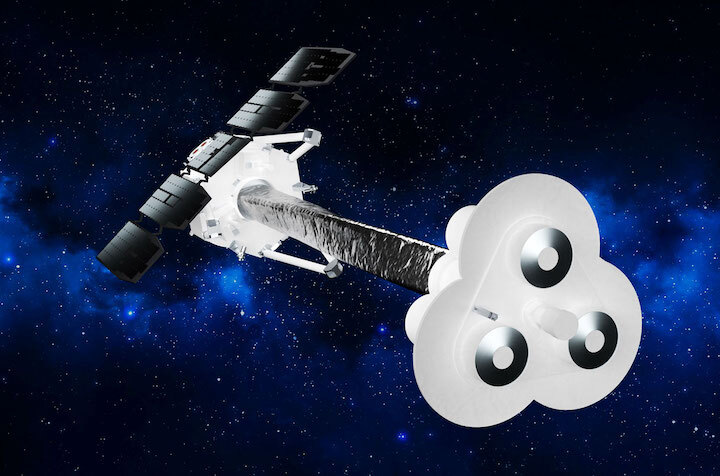
Next week, NASA will launch a small mission with an ambitious task: to peer into some of the universe’s most violent objects for clues to how they work. By detecting how intense magnetic fields in collapsed stars and black holes align, or polarize, the x-rays they emit, the Imaging X-ray Polarimetry Explorer (IXPE) could reveal how those objects spew out radiation in the first place. “We’re just trying to find out how do you produce these x-rays anyway,” says principal investigator Martin Weisskopf of NASA’s Marshall Space Flight Center.
“The community has been waiting for this for a long time,” says x-ray astronomer Feryal Özel of the University of Arizona, who is not part of the project. NASA’s Orbiting Solar Observatory 8, launched in 1975, detected a smattering of polarized x-rays from a single source, the Crab nebula, Weisskopf says. Since then, the questions such x-rays might answer have piled up, but no mission has set out to measure them—in part because the data from that first sensor suggested there might be too few to be worth the effort. Weisskopf says he proposed dedicated x-ray polarimetry missions several times before succeeding with IXPE, a $190 million mission that is set to launch on 9 December from the Kennedy Space Center in Florida on a SpaceX Falcon 9 rocket.
X-rays are emitted when gas is heated up to hundreds of millions of degrees Celsius and ionized to produce plasma, a roiling soup of electrons and ions. Typically, the photons’ own magnetic and electric fields oscillate perpendicularly to their path, but in random directions. However, magnetic conditions at their birth or interactions on their journey can polarize the photons by forcing those oscillations into the same plane.
IXPE will spend at least 2 years scrutinizing cosmic x-ray sources with three identical telescopes—cheaper than one big one and a hedge against failures. Each telescope is a cylinder containing two dozen concentric shells that focus x-rays through grazing reflections (x-rays penetrate standard telescope mirrors). Sensors provided by the Italian Space Agency detect the x-rays and their polarization in a layer of dimethyl ether gas. An x-ray hitting a gas atom knocks out an electron that tends to shoot off in the direction of polarization, leaving a visible trail. Imaging many trails and their spread tells observers how polarized the light is, and in which direction.
Pulsars are a prime target for IXPE. These city-size remnants of dead stars spin frenetically, sometimes hundreds of times per second, emitting beams of radio waves, x-rays, and other radiation that sweep past Earth like a lighthouse beacon. Weisskopf says rival theories of beam generation suggest the x-rays originate in different locations on the pulsar: all across its surface, at its poles, or in its atmosphere. Each theory predicts the x-ray polarization signal should vary with the timing of the pulses in a way IXPE should be able to distinguish. “We will get a result, as long as we launch,” he predicts.
Also in the mission’s sights are magnetars, stellar remnants like pulsars, but with even more powerful magnetic fields, 100 million times stronger than any magnet made on Earth. The magnetic field lines force fast-moving electrons into helical paths, causing them to spray out polarized x-rays known as synchrotron radiation. By measuring how the polarization of the x-rays changes as the magnetar spins, observers will be able to map the geometry of the field across the entire globe—and watch for tangles that lead to eruptive outbursts. “With IXPE we may really see the magnetic field direction, the twisted magnetosphere,” says theorist Matthew Baring of Rice University.
Polarization could also reveal how hungry the supermassive black hole at the center of our Milky Way has been in recent history. Gas and dust swirling around an active, accreting black hole shine brightly with x-rays as they are ferociously heated by gravitational forces close to the event horizon. The x-rays now arriving directly from the Milky Way’s black hole are dim, suggesting it is quiescent. But x-rays emitted longer ago could also be arriving, having followed dogleg paths after being scattered by distant gas clouds. That scattering should imprint a polarization on the x-rays, a sign that they came from the galactic center and not the cloud itself. “If we look at clouds and see polarization, that would be a smoking gun,” says astrophysicist Philip Kaaret of the University of Iowa, who worked on a rival polarimeter proposal that lost out to IXPE. Their brightness might show whether the black hole was more active tens of thousands of years ago.
IXPE’s biggest coup might be in helping understand the mechanics of immensely powerful jets launched by supermassive black holes in distant galaxies. These jets blast material up to 10 million light-years out into space—that’s 100 times the diameter of the Milky Way. Researchers believe that fields generated by churning charged particles in the accretion disk combine with the black hole’s own magnetic field to funnel material and field lines into the jets, which spew from both poles.
Other x-ray telescopes have seen x-rays emitted close to the root of the jet, and researchers believe that synchrotron radiation is responsible. But what powers the electrons to near-light-speeds as they spiral around the field lines? One possibility is shockwaves of fast-moving plasma. Another is magnetic reconnection, when stressed field lines snap and reconnect, releasing energy that can accelerate electrons.
Polarization measurements by IXPE could offer insight into how big and chaotic this emission region is and what accelerates the electrons. They might even show both processes are at work, Baring says. “That makes nature richer,” he says, “and keeps theorists busy.”
Quelle: AAAS
+++
Update: 6.12.2021
.
SpaceX test-fires Falcon 9 rocket ahead of NASA science probe launch
SpaceX completed a static fire test of a Falcon 9 rocket Saturday at NASA’s Kennedy Space Center in preparation for a launch Dec. 9 with the space agency’s Imaging X-ray Polarimetry Explorer science mission.
The test-firing of the Falcon 9 rocket occurred at 12:18 p.m. EST (1718 GMT) on pad 39A at the Florida spaceport. SpaceX rolled the rocket, without its payload fairing or the IXPE spacecraft, out to pad 39A Friday afternoon and raised it vertical on the launch mount overnight.
SpaceX loaded kerosene and liquid oxygen into the two-stage launcher beginning 35 minutes prior to the static fire test. The nine Merlin engines at the bottom of the booster ignited for less than 10 seconds as hold-down restraints kept the Falcon 9 on the ground.
The static fire test is a customary part of most SpaceX launch campaigns, giving engineers a chance to rehearse countdown procedures and verify ground and rocket systems are ready for launch day.
SpaceX engineers will review data from the test-firing to ensure everything worked as expected. Teams will lower the Falcon 9 rocket and return it to the hangar a quarter-mile south of pad 39A for attachment of NASA’s IXPE spacecraft.
The fully-assembled launch vehicle will return to pad 39A Tuesday in preparation for a 90-minute launch window Thursday, Dec. 9, opening at 1 a.m. EST (0600 GMT).
The IXPE mission is designed to measure the polarization of high-energy cosmic X-rays, collecting data that will allow astronomers to study the unseen environment around black holes, neutron stars and pulsars, the extremely dense collapsed remains left behind by exploding stars.
Astronomers hope IXPE will reveal the spin of black holes, and yield new discoveries about the extreme magnetic fields around a special type of neutron star called magnetars.
In order to obtain the sensitivity required for the X-ray research, the IXPE observatory will host three identical X-ray telescopes that will be extended after launch on a 13-foot (4-meter) boom. Built at Marshall Space Flight Center, the mirror module assemblies at the end of the boom will focus X-rays onto detectors provided by ASI, the Italian space agency.
The IXPE spacecraft, built by Ball Aerospace, weighs 727 pounds (330 kilograms) at launch, according to a NASA spokesperson.

The relatively small size and mass of the IXPE observatory falls well short of the normal capacity of SpaceX’s Falcon 9 rocket.
But IXPE will launch in a unique equatorial orbit from Cape Canaveral, requiring a significant sideways burn, or plane change maneuver, with the Falcon 9’s upper stage before deployment of the spacecraft at an altitude around 335 miles (540 kilometers).
NASA selected IXPE to become the next in the agency’s line of Small Explorer missions in January 2017. At the time, NASA said the IXPE mission would cost $188 million, covering development of the spacecraft and its X-ray telescope payload, a launch vehicle, and two years of operations.
In 2019, NASA signed a $50.3 million contract with SpaceX to launch the IXPE satellite on a previously-flown Falcon 9 booster from the Kennedy Space Center.
The orbit hugging the equator will minimize the X-ray instrument’s exposure to radiation in the South Atlantic Anomaly, the region where the inner Van Allen radiation belt comes closest to Earth’s surface.
The launch of IXPE will mark the 28th launch of a SpaceX Falcon 9 rocket this year, following a blastoff Thursday night from nearby pad 40 at Cape Canaveral Space Force Station with the next batch of Starlink internet satellites.
SpaceX plans to recover the first stage booster after the IXPE launch on the drone ship “Just Read the Instructions” in the Atlantic Ocean east of Florida.
Quelle: SN
----
Update: 8.12.2021
.
SpaceX Falcon 9 rocket rolls out to launch pad with NASA X-ray telescope

A SpaceX Falcon 9 rocket carrying NASA’s tiny IXPE X-ray telescope has rolled out to Kennedy Space Center (KSC) Pad 39A for the last time ahead of a planned Thursday, December 9th launch.
Falcon 9 is scheduled to lift off at the start of a 90-minute window that opens at 1am EST (06:00 UTC). The only payload: a first-of-its-kind 330 kg (~730 lb) spacecraft known as the Imaging X-ray Polarimetry Explorer (IXPE) that hopes to analyze the polarization of X-rays to explore black holes, nebulae, and bizarre lighthouse-like dead stars called pulsars in unprecedented detail. The mission is also interesting just for the sheer disparity between the size of the payload and the rocket that will launch it.
As noted, IXPE will weigh about a third of a ton at launch. SpaceX’s Falcon 9, on the other hand, will weigh roughly 550 tons (1.2M lb) when it lifts off, resulting in a truly unusual payload ratio of approximately 1:1700 or 0.06%. However, Falcon 9 will still have to work extremely hard to get IXPE into the correct orbit. That’s because IXPE is designed to operate in an almost exactly equatorial orbit with a zero-degree inclination.
Launching out of Cape Canaveral, which is located 28.5 degrees above the true equator, it’s physically to launch directly into a 0.2-degree equatorial orbit. Instead, a rocket needs to launch into a due-East parking orbit and then perform what’s known as a plane or inclination change once in space. Plane changes are infamous for often being (in terms of rocket performance) one of the most expensive maneuvers one can perform in orbit. That’s certainly the case for IXPE, which will require a 28.5-degree plane change shortly after liftoff.

NASA’s DSCOVR, TESS, and DART spacecraft ahead of Falcon 9 launches. (NASA)
For Falcon 9, that means that even the tiny ~330 kg IXPE likely still represents about 20-30% of its maximum theoretical performance (1.5-2 tons) for such a mission profile, while the same rocket is otherwise able to launch about 15 tons (33,000 lb) to the same 600 km (373 mi) orbit IXPE is targeting when no plane change is needed. As an example, per a NASA calculator with access to official performance data, Blue Origin says its massive New Glenn rocket – designed to launch more than 40 tons (~90,000 lb) to low Earth orbit (LEO) – can only launch about 2 tons (~4500 lb) to IXPE’s planned orbit
SpaceX is no stranger to launching absurdly small NASA spacecraft, including the ~700 kg (~1500 lb) Double Asteroid Redirection Test (DART) just last month, but IXPE – about 10% lighter than TESS – will be the smallest dedicated payload ever launched by Falcon 9. Following the launch, Falcon 9 booster B1061 will attempt its fifth drone ship landing more than 650 km (400 mi) downrange. Demonstrating just how much more challenging IXPE’s plane change makes an otherwise effortless launch to 600 km, an older and less capable Falcon 9 booster landed just 300 km (185 mi) downrange after launching TESS to an orbit as high as 375,000 km (233,000 mi) – about the same distance between the Earth and Moon.
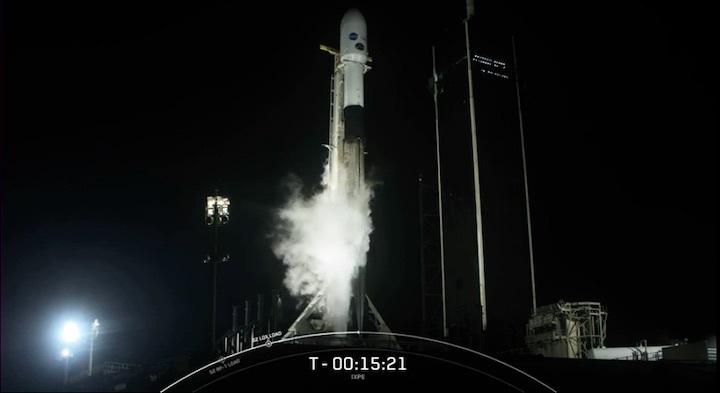


















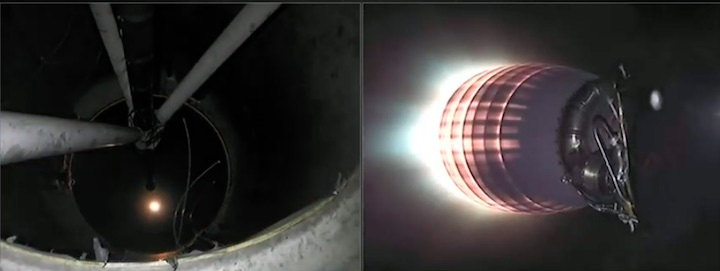
















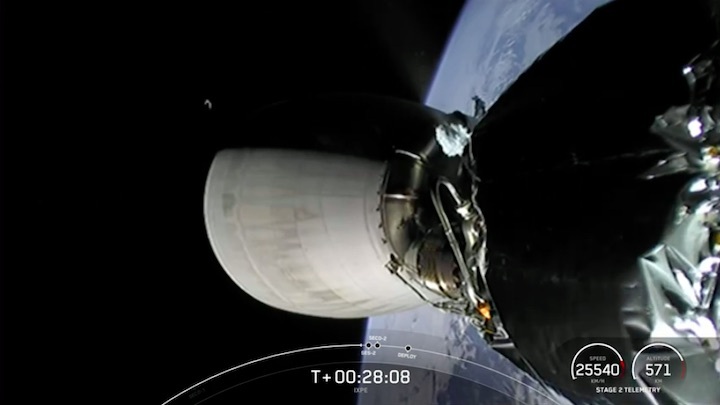










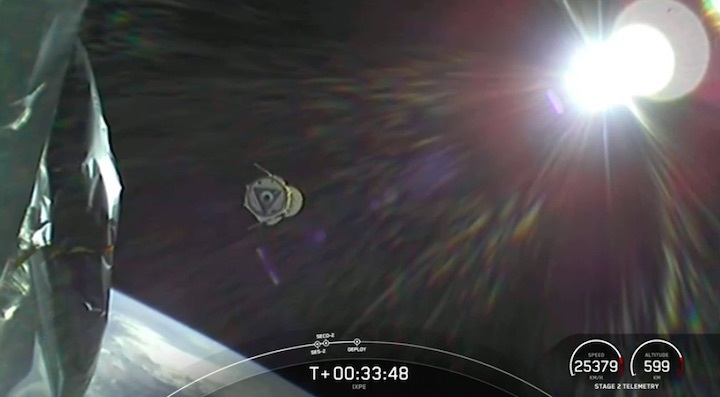






SpaceX launches NASA's IXPE observatory to study exotic deep space objects

SpaceX launches NASA's IXPE observatory from Kennedy Space Center
A SpaceX Falcon 9 rocket boosted its smallest payload to date early Thursday, taking an ambitious NASA mission to Earth orbit via an unusual trajectory that began at Kennedy Space Center.
The 230-foot rocket doglegged after lifting off from pad 39A at 1 a.m. sharp, adjusting its trajectory toward a southeast bias to deliver the Imaging X-ray Polarimetry Explorer, or IXPE, to equatorial orbit. Most missions launching from the Space Coast fly northeast.
Nine minutes after liftoff, SpaceX teams confirmed a successful landing of Falcon 9's 162-foot first stage on the Just Read the Instructions drone ship the Atlantic Ocean. The booster should return to Port Canaveral by this weekend.
Falcon 9's 43-foot payload fairing, meanwhile, stood cavernous next to IXPE, which measured 17 feet long and 8 feet wide with its solar arrays deployed. But despite its size, the small spacecraft punches above its weight.
The $188 million mission – $50.3 million of that for launch – will study X-rays emanating from exotic deep-space objects like black holes and the collapsed cores of massive stars known as neutron stars. IXPE will use three identical telescopes to observe polarization, or directional properties of X-rays, from these objects.
"I can't swear, so I'll just say it was awesome," said NASA's Martin Weisskopf, the principal investigator for IXPE. "I've seen many launches in my career and this was picture perfect."
"I almost can't describe the feeling. I'm numb with excitement and I'm looking forward to the next 30 days when we make sure everything works," he said.
Just over 30 minutes after liftoff, SpaceX confirmed successful separation of the spacecraft from Falcon 9's second stage. IXPE is a collaboration between NASA's Marshall Space Flight Center in Huntsville, Alabama, the Italian Space Agency, and Colorado-based Ball Aerospace.
SpaceX's success early Thursday paves the way for its next two attempts: the launch of a Turkish communications satellite and a Cargo Dragon resupply mission to the International Space Station.
First up is Turksat 5B: yet another Falcon 9 will launch from Cape Canaveral Space Force Station's Launch Complex 40 no earlier than 11:58 p.m. Saturday, Dec. 18. It will mark the second time SpaceX launches a Turkish communications satellite designed for both private and government use.
Finally, the year's last mission is slated to feature an uncrewed Dragon capsule packed with thousands of pounds of cargo, science experiments, and supplies for the crew of the International Space Station. Liftoff from pad 39A is set for 5:06 a.m. Tuesday, Dec. 21.
It will mark SpaceX's 24th resupply flight under contract by NASA, also known as Commercial Resupply Services-24 or CRS-24.
Quelle: Florida Today

